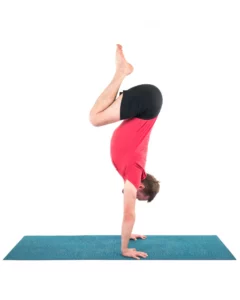Wake Up Your Arms: 3 Ways to Bring Awareness to your Arms in Yoga’s Standing Poses

Standing poses in yoga commonly favor the lower body. In teaching standing poses, for example, many of the cueing points focus on what you are doing or feeling in the hips, knees, ankles, and feet. But regardless of the poses you are practicing, the entire body plays a role and impacts the totality of each asana.
Transferring your awareness from your lower body to your upper body in standing poses can change your entire perspective, which might generate more interest in the role the upper body plays in these asanas.
Try the following ideas to bring more awareness to your arms in standing poses.
Focus on Arms: Press Into a Wall

The wall offers a structure to help heighten spatial awareness. You can press your hand into the wall, and from the pressing of your hand, you can feel what’s happening in your shoulder due to closed chain reactions. You can also feel how much your body moves in space when you move away from the wall, but try to maintain the closed chain.
Let’s take Virabhadrasana II (Warrior II) as an example of how you can bring awareness to the arms with the use of a wall.
- Place a non-skid yoga mat on the floor next to a wall so that it is oriented perpendicular to the wall.
- With the feet spread approximately three to four feet apart, depending on the length of your legs, set up the outer edge of your right foot against the wall (or a block against the wall) and your left toes facing the front of your mat.
- Press your right palm into the wall at shoulder level with your elbow bent.
- Bend your left knee slowly into Warrior II, and as you do so, slowly push into the wall as you straighten the right arm.
- Be aware of the forward movement of the pose. But also be aware of the closed connection between your shoulder, hand, and the wall help to keep your awareness alive in the back of the arm. Because awareness of the back arm can easily be lost in this pose when we practice in the middle of the room, pressing the hand into the wall helps you maintain awareness of this area of the body, which gives you a more “global” body awareness.
Yoga and Arms: Use Light Weights

Using light weights helps highlight the role of the arms in standing poses. Some practitioners are able hold their arms in a certain position for a lengthy period of time without necessarily feeling the relationship between the arm, the shoulder, and the torso. For example, it is common for students to extend the top arm behind the torso in Trikonasana (Triangle Pose), because they are concentrating on what’s happening in the lower half of the body. When cued to lift the top arm, that student may be confused by a lack of awareness of the space around the top arm.
A light weight is useful because it helps us understand where our body is in space, particularly if we don’t have access to a wall or door. If the arm extends behind the shoulder, we can feel it immediately because there is more pull on the front of the shoulder as the arm reaches behind us. When the arm is in front of our body, the opposite happens. The inner arm feels forward momentum from the weight. The arm becomes heavy and wants to come down immediately in front of us. When the load is located directly on top of the shoulder, we feel the rebound action as we extend upward through the arm.
Let’s take a look at Trikonasana.
- Stand with your feet comfortably apart with your right leg turned out 90 degrees and your left leg turned in about 30 degrees.
- Have the light weight in your left hand and let your arm rest at your side.
- Keeping your knees straight, tilt your pelvis to the right, let your torso follow, and place your right hand on a support, such as a chair or a block.
- Lift the weight slowly overhead to notice how the muscles of the shoulder react to reaching the arm overhead. Then mindfully take the weight in micro movements until you feel the arm positioned comfortably on top of your shoulder.
Practice with Therabands

Due to their resistance and flexibility, therabands offer a unique sense of feedback. They are very stimulating in a yoga practice and enliven the exploration of bringing awareness to your arms in standing poses.
Let’s use Utkatasana (Fierce Pose) as an example.
- Place a long theraband under your feet (you can also use two, one under each foot) and tie it to your wrists.
- Bend your knees and slowly lift your arms, noticing the work of the arms and the backs of the shoulders as they rise. Make sure that when you bend your knees and lift your arms, there is resistance. If there isn’t, make the band shorter. The resistance should be present after you bend your knees and begin to lift your arms.
- Observe the difference between lifting one arm and not the other.
- You can test by letting go of the theraband on one side. Compare how you feel lifting the arm with the theraband to how it feels lifting the arm without the theraband.
Working with these different types of props gives us feedback that enables us, as students, to learn about how our bodies move. You will also notice that the wall, weights, and therabands offer diverse qualities. This allows us to gain awareness in our arms in multiple ways so that we can take this kinesthetic memory into practice when we choose to work without props.
Also, read...
Warrior I Pose: 5 Strengthening Variations
Deepening Your Home Yoga Practice: An Interview with Judith Hanson Lasater
4 Easy Ways to Use a Sandbag in Yoga Practice
Related courses
Breath as Medicine: Yogic Breathing for Vital Aging
Yoga and Myofascial Release: Releasing Chronic Tension with the Bodymind Ballwork Method
Yoga and Detoxification: Tips for Stimulating Lymphatic Health

Allison Ray Jeraci, E-RYT 500, RPYT, is a vinyasa-based yoga teacher, fascinated by the intricate relationship between the mind and body. She offers a range of alignment-focused classes touching on anatomy, philosophy, and creative propping with a mindful approach. In addition to teaching group classes and managing the Yoga Culture studio in Danbury, CT, she also teaches at Open Door Family Medical Center in Westchester, NY, empowering mothers-to-be with prenatal yoga classes and childbirth education. You can find her @allisonschleck on Instagram and www.allisonrayjeraci.com.



